 Nothing says “I Love You” more than homemade noodles.
Nothing says “I Love You” more than homemade noodles.
If you grew up in the Midwest, you know I’m talking about the homemade noodles like your mom or grandma used to make. And, to be very clear, homemade noodles are NOT pasta.
No, homemade noodles are wonderful comfort food goodness, best eaten with a roasted chicken or turkey. Some like to pour them over mashed potatoes, and some prefer to eat them as a stand-alone part of the meal. I may, or may not have been known to eat them for breakfast.
I prefer to make them thinner, like my mom made. Or, you can make them a little larger and call them dumplings. Like chili, the making and consumption of noodles is a personal, individual choice.
And with that last sentence, I decided I had to make some RIGHT NOW. 😀 Sorry about the less than stellar picture quality. Turns out my kitchen lighting isn’t so good for cooking on cloudy days. :-/
Learning how to make homemade noodles is a talent passed down from older generations. You still have time to practice and impress your family!
You almost can’t screw them up!
The keys to this recipe:
You need a really, really sharp clean knife.
Use flour liberally. And then use more. Like, you can’t really use too much.
Cut the noodles as thin as you possibly can.
Here’s the recipe, along with some play-by-play info. 🙂 Even the eggs are happy to be made into noodles. 😉
Mom Gunnels’ Noodles
3 eggs
2 Tablespoons milk. Whole milk or 2% is best, although when I made this last batch, I had to borrow 1% from my neighbor. Other than a slightly different texture with the dough, we couldn’t tell any difference in flavor.
Salt (I use kosher, probably about 1/2 teaspoon)
1 1/2 Cups Flour
2 Tablespoons chicken bouillon granules
2-3 LARGE cans chicken broth I usually buy reduced sodium broth, since the broth granules have quite a bit of sodium in them. You can always salt them more, but not less!
Mix together all ingredients with a fork, adding more flour if necessary until you have a stiff dough that’s too stiff to stir.
Divide the dough into thirds, adding flour if needed to make it less sticky and easier to handle.
Some of these pictures are from last year, when I taught my friend Peggy how to make noodles. Her husband is from Pittsburgh, so we enjoyed introducing him to the glory of homemade noodles gently spooned over a mound of mashed potatoes.
Using 1/3 of the dough at a time, place it on a large, liberally-floured cutting board.
Adding more flour as you go (see what I mean?), roll it it out very thin, as if you were making a pie crust.
(I think I’ve made pie crust like, 3 times in my life. But I’ve seen it done. ) The best comparison I can think of would be a large flour tortilla.
It’s very likely you’ll need to keep adding flour, as it may get sticky as you roll it out.
Once the dough is rolled out flat and nice and thin, pick up one side and fold it over in half. Add more flour if necessary.
Then fold it in half again, so it’s 1/4 of its original size.
Starting from the side with the fold, gently roll the dough up.
Holding the rolled dough gently in one hand, start slicing thinly from one end (like 1/8″ thick, or as thin as you can get them.) I typically use gentle sawing motions in order not to squish the dough.
Once the rolled dough has been sliced, add some flour and toss the mound of noodles gently within the flour until they are broken apart and in a loose pile.
Slide to the corner of the cutting board, and repeat these steps with the other 2/3 of the dough.
Once all the dough is sliced and tossed, add more flour and toss it all together, then spread out across the cutting board in a thin layer.
They will look something like this. The noodles do best if they’ve had some time to dry. Typically, I cover them with paper towels and let them dry overnight. If I’m going to cook them the same day, I leave them uncovered.
When I was a kid, I used to love to eat raw noodle dough. My grandmother, horrified, always told me not to eat too many because they would plug up my butt. 😀
Oh, the memories.
Two or three hours before you plan to serve them, heat up two large cans (like the size you’d buy canned juice in) of chicken broth in a large dutch oven along with the chicken broth granules. You don’t want this to boil, you just want it to heat up so the granules dissolve.
Gently scrape the noodles into the dutch oven, and stir to break up any clumps. Turn the heat to a low temperature; ideally, you want these to barely simmer. Too hot and the noodles will stick to the bottom of the pan.
Stir frequently during the first half hour, and periodically after to make sure they don’t stick to each other or the pan. Leave the pot uncovered, letting the steam rise, and the noodles bubble ever so gently.
Simmer until the broth reduces and the noodles have a gravy-like texture. If your noodles are bigger, you may need to add more chicken broth during this period to ensure the noodles are fully cooked in their own gravy.
When you can no longer keep your family out of them, you know they are ready. 😀
My husband’s favorite way to eat them is drizzled over turkey, dressing and mashed potatoes. Or chicken and stuffing. Or by themselves.
How do you like to eat your noodles?
Happy Thanksgiving, friends!

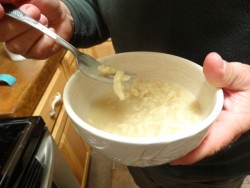
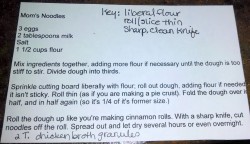






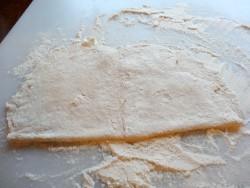

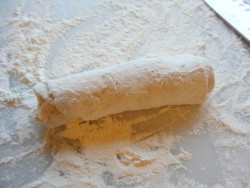



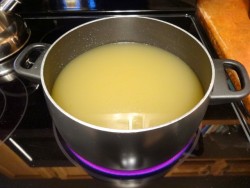



I use a pizza cutter to make thin noodles!
That’s a great idea too! Do you just leave the dough rolled flat and slice them then?